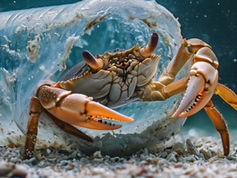How and Why Does Ocean Water Move?
- Lauren A. Moe

- Mar 16, 2023
- 3 min read
Updated: Jul 7, 2023
Ocean water is constantly on the move, but why? Sure, we know about currents, tides, and waves, but two lesser-known factors also play a role in where the water ends up: temperature and salinity. Let’s break it down.
The first term you need to know is “water mass”. A water mass is a volume of water (however big or small) that has an identifiable temperature and salinity, as well as other properties such as nutrients and oxygen content. Water masses are commonly used in oceanographic studies to identify where a sample originated from. They are divided into upper waters (less than 500 m), middle/intermediate waters (500-1500 m), and deep waters (greater than 1500 m), as well as by geographical region. One prominent water mass is the North Atlantic Deep Water, with temperatures between 1.5-4.0°C, and salinity in the range of 34.8-35.0.
Surface currents in the ocean are largely driven by wind patterns, but middle and deep water currents rely on the characteristics of water masses. Seawater density is determined primarily by temperature and salinity. When you have two water masses, the warm water will rise, and the cold water will sink. This all boils down to the molecular level: warmer water molecules are farther apart than cold molecules, making cold water heavier and denser than warm water. When you put an ice cube in a glass of water, the ice cube floats, right? This isn’t because of its temperature, but rather because water is denser than ice. The salinity of water affects its density in the same way. When salt dissolves in water, the volume of water remains the same, but the weight increases. The added salt makes seawater heavier (and denser) than fresh water.
So what does this all have to do with ocean movement? Well, the next term you need to know (thermo- meaning temperature, and -haline meaning salt or salinity) is “thermohaline circulation”. Differences in water masses’ temperature and salinity control how water moves up and down in the ocean. In cold climates, brisk air can cool down the surface water, making it denser. Alternatively, when the sun heats the ocean surface, the water evaporates and leaves behind salt, leading again to denser waters. These dense waters slowly sink and are replaced by warmer, less salty waters. On the other hand, rainwater, which is primarily freshwater, can slow this process by adding less dense water to the surface.
The Great Ocean Conveyor Belt (another name for thermohaline circulation), replaces seawater from the deep ocean with surface water and replaces surface water with rising deep water. This movement is vital for ocean life. Surface waters become depleted of nutrients over time but are enriched again as they travel and sink. Over a 1000-year-long journey, water circulates around the globe on this Great Ocean Conveyor Belt (shown below).

Picture credit: NOAA, “Why does the ocean get colder at depth?”
Differences in water masses can lead to interesting phenomena such as underwater waterfalls. Earth’s largest waterfall (3 km/1.9 miles) exists beneath the Denmark Strait, between Iceland and Greenland. As the warm surface waters flow northward, the frigid, dense waters from the Nordic Seas flow southward. When the cold waters reach the drop-off point, they form a fast downward flowing current appearing much like the waterfalls we know.

Picture credit: NOAA, “Where is Earth’s Largest Waterfall?”






Comments